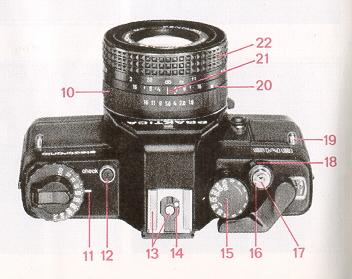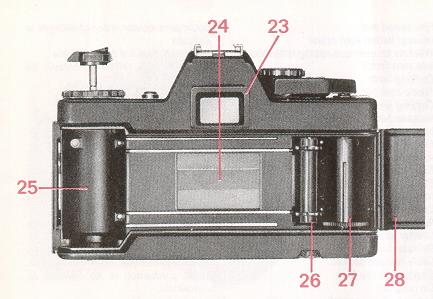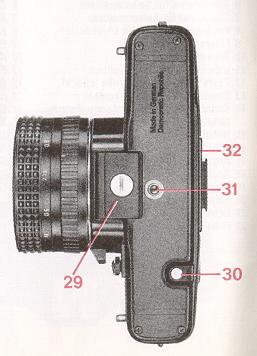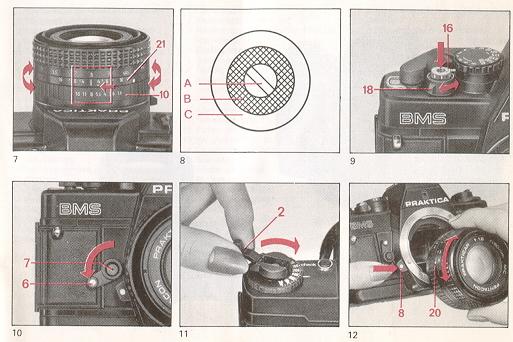If you find this manual
useful,
how about a donation of $3 to:
M. Butkus, 29 Lake Ave.,
High Bridge, NJ 08829-1701
and send your
e-mail address
so I can thank you.
Most other places would charge
you $7.50 for a electronic copy
or $18.00 for a hard to read Xerox copy.
This will help me to continue to host this site,
buy new manuals,
and pay their shipping costs.
It'll make you feel better, won't
it ?
If you use Pay Pal, use the link below.
Use the above address for a check, M.O. or cash.
If you use PayPal.. use the link below
Venmo @mike-butkus-camera Ph. 2083
<<<
IF YOU WOULD LIKE THIS OR ANY PDF FILE
PRINTED, BOUND AND MAILED TO YOU,
SEE THIS OUTSIDE COMPANY'S OFFER >>>
Praktica BMS
PDF straight from manual
Praktica BMS Bedienungsanleitung
Praktica BMS instrucciones para el uso
CLICK HERE FOR A Praktica BMS PDF
English VERSION OF THIS PAGE
CLICK HERE FOR A TRANSLATED
from HTML
PRAKTICA BMS MODE D'EMPLOI
CLICK HERE FOR A TRANSLATED
from HTML
PRAKTICA BMS Bedienungsanleitung
Requires a PB bayonet lens called a Prakticar
Not a Pentax K-mount

For more information on this camera, see this personal website
PRAKTICA BMS These instructions refer also to the PRAKTICA BM.
Only the information given for the self timer is only applicable to the PRAKTICA BMS.
 |
1. Film speed dial
2. Rewind button with crank
3. Window for aperture setting reflection into viewfinder
4. Winding lever
5. Frame counter
6. Winding /ever for self-timer
7. Release button for self-timer
8.. Lens unlocking key
9. Filter thread |
 |
10. Aperture setting ring
11. Film speed index
12. Battery check button
13. Hot shoe with center contact
14. Contact for dedicated computerized flash units
15. Shutter speed dial
16. Release button
17. Cable release socket
18. Shutter release lock
19. Carrying lug
20. Lens positioning mark
21. Depth-of-field scale
22. Focusing ring |
 |
23. Eyepiece with accessory holder
24. Shutter
25. Film cartridge space
26. Film sprocket
27. Take-up spool
28. Camera back
|
 |
29. Battery compartment lid with
locking button
30. Rewind release button
31. Tripod socket
32. Plug-in frame {memo holder}
|
Technical features
· single-lens reflex 24mmx36mm frame size TTL light metering at full
aperture through electronic aperture setting transfer.
· automatic shutter speed control from 1/1000s to 4s; aperture or shutter
speed priority
· film speed range from ISO 12 to ISO 3200
· viewfinder information through LEDs in different colors
· shutter speeds from 1/1000s to 4s
· warning of overexposure and underexposure
· flash readiness
· battery check
· aperture setting reflected into viewfinder
· focusing system: Fresnel lens with diagonal triple wedge, microprism
ring and ground glass ring
· Viewfinder image shows 95% of picture sides - electronic flash
synchronization at 1/60s - PRAKTICA bayonet (flange focal length 44.4mm;
inner diameter 48.5mm) - self-timer (approx. 8s) with release button -
memo holder on camera back - power source: 6 V primary battery - light
receiver: silicon photocell - measuring and control range: 0... 17EV at
ISO 100 and aperture 1.4
- body dimensions: 138mmx87mmx49mm weight (body without battery): BMS 480
g, BM470g.


Inserting the battery -
A 6V battery powers the whole electronic | system. Suitable are
alkali-manganese, silver oxide and lithium batteries. Four button cells (e.g.
LR 44) inserted in a sleeve (identification no.961 363) can also be used.
Normally, a fresh battery will last for about 2 years. To insert the battery,
turn the locking but- ' ton of the battery compartment lid (29)
counterclockwise until the lid can be opened. Clean the contacts in the
compartment and the battery Does using a dry cloth. Press the plus pole of the
battery against the resilient contact (see the polarity marks on the inner
side of the lid) and tip the battery in (Figure 1). Close the lid and lock it.
It is recommended to check the contact points of the battery and compartment
from time to time and clean them, if necessary. The battery is sensitive to
low temperatures and should be protected in a suitable manner. If the camera
is not used for an extended period, take the battery out of the compartment.
Checking the battery
First press the release button (16) slightly and then button
(12); see Figure 2. The battery is sufficiently charged if the LED
indication is bright. The LEDs go out if the battery is spent. Check for
about 1 second.
In the "B" setting the battery cannot be checked.
Opening the camera back
Pull the rewind button (2) up
to unlock the camera back (Figure 3). Open the back fully -the frame
counter resets to start position.
Loading the film
Place the film cartridge into the
cartridge space (25). Push in the rewind button (2); turn it, if
necessary.
Thread at /east 1 cm of the film leader into the slit of the take-up spool
(27). Then turn the knurled spool plate of the take-up spool towards the
shutter until the sprocket teeth engage the perforations on both sides of
the film (Figure 4).
Closing the camera back
Grip the back in the middle of the latch side and press it against the
camera body until it clicks in.
Preparing for shooting
The winding lever (4) can be swiveled a short way without initiating
winding. This ready position is ideal for shooting fast sequences. Swing
the winding lever fully out, bring it back and release the shutter by
pressing the release button (16). Repeat this as often as is required for
the frame counter (5) to read "1 "
Proper film transport can be checked by looking at the rewind button (2):
it should turn when the winding lever (4) is operated.
Setting the film speed
Lift the film speed dial (1) and turn it until the ISO/ASA film speed
printed on the film pack (see the ISO/ASA and DIN film speed reference
table below) faces the index (11); see Figure 5. As a memory aid, you may
plug the torn-off flap of the film pack into the memo holder (32).
ISO/ASA and DIN film speed see table page 16
Working ranges
With TTL light metering at full aperture, the camera can cover
the following shutter speed ranges for the various film speeds. Table
below
| ISO |
F 2.8 |
F4 |
F5.6 |
F8 |
F11 |
F16 |
F22 |
| 100 |
4 - 1/1000 |
4 - 1/1000 |
4 - 1/1000 |
4 - 1/1000 |
4 - 1/1000 |
4 - 1/500 |
4 - 1/250 |
| 200 |
4 - 1/1000 |
4 - 1/1000 |
4 - 1/1000 |
4 - 1/1000 |
4 - 1/1000 |
4 - 1/1000 |
4 - 1/500 |
| 400 |
2 - 1/1000 |
4 - 1/1000 |
4 - 1/1000 |
4 - 1/1000 |
4 - 1/1000 |
4 - 1/1000 |
4 - 1/1000 |
| 800 |
1 - 1/1000 |
2 - 1/1000 |
4 - 1/1000 |
4 - 1/1000 |
4 - 1/1000 |
4 - 1/1000 |
4 - 1/1000 |
| 1600 |
1/4 - 1/1000 |
1 - 1/1000 |
2 - 1/1000 |
4 - 1/1000 |
4 - 1/1000 |
4 - 1/1000 |
4 - 1/1000 |
|
3200
|
1/4 - 1/1000 |
1/2 - 1/1000 |
1 - 1/1000 |
2 - 1/1000 |
4 - 1/1000 |
4 - 1/1000 |
4 - 1/1000 |
Setting the shutter speed
Turn the shutter speed
dial (15) until the desired speed faces the index ("125-in Figure 6). The
LED next to "125" will flash when the release button is slightly pressed.
4s to 1/15s - for shots where the object brightness is low, a
tripod is needed
1/30s to 1/1000s - for shots where the object brightness is
sufficient
Symbol 60  - for shots with an electronic flash gun (time is mechanically formed, also
without a battery)
- for shots with an electronic flash gun (time is mechanically formed, also
without a battery)
Setting the aperture
Turn the aperture setting ring (10) until the desired a aperture matches
the index mark on the lens mount (Figure 7). The aperture setting is
reflected into the lower part of the viewfinder.
Recommended apertures for a film speed of ISO 80:
| |
Aperture |
| Full sunlight |
8. . . 11
|
| Overcast |
4 . . . 5.6 |
| Close-ups |
not less than 8 |
The aperture can also be preselected on the basis
of the depth of field desired for the subject taking into account the
shutter speed information in the finder so as to avoid blurring. A small
aperture means a great depth of field, whereas a large aperture gives a
shallow depth.
Focusing
Focusing is possible with the triple wedge, microprism ring and ground
glass ring (Figure 8).
A Triple wedge
The triple wedge system allows highly accurate focusing. Optimum
sharpness is obtained when contours and lines flow naturally. The object
focused on is out of focus when the contours of the center wedge are out
of alignment.
B Microprism ring
The subject is in proper focus when the image in this field is clear and
does not flicker.
C Ground glass ring
This focusing ring is of advantage in photomacrography and
photomicrography, but also when the lens used has a small relative
aperture (f-numbers greater than 4). The image in the ring shall be
clear and sharp.
Infrared shots
Infrared shots call for a slight correction of the distance setting:
after focusing in the normal way, match the distance so determined with
the infrared index on the lens barrel.
The arrow in Figure 7 points to the infrared index.
Depth-of-field indication
The depth-of-field limits for the aperture set can be read from the
depth-of-field scale (21) on the lens (Figure 7).
Example: distance 3 m, aperture 8 - depth of field stretches from about
2m to 5m
Semi-automatic mode
There are two possibilities:
1. Shutter speed is preselected, aperture is adapted (preferable with
good lighting conditions and normal shots)
2. Aperture is preselected, shutter speed is adapted (favorable with
poor lighting conditions when a certain depth of field is required)
Shutter speed is preselected
Set the desired time
by turning the shutter speed dial (15). Press the release button (16)
halfway down to switch on the camera electronics. Check the shutter
speed by means of the finder LEDs.
While the LED pertinent to the preselected shutter speed flashes,
another LED, which shines permanently, indicates the shutter speed
required for the available lighting conditions, film speed and aperture.
Two LEDs may light in the case of intermediate values. To set the camera
for correct exposure, turn the aperture setting ring (10) until the
flashing LED is permanently on. The aperture so set can be seen at the
lower edge of the viewfinder.
Apertures preselected
Set the
desired aperture by turning the aperture setting ring (10). Switch on
the electronic system by pressing the release button (16) halfway down.
The shutter speed indication will be as described above, i.e. the LED
for the shutter speed set will flash, whereas the shutter speed actually
needed for a correct exposure is indicated by a permanently lit LED.
Turn the shutter speed dial until the flashing LED moves toward the
permanently lit one, and finally coincides with the latter.
There is no LED display in the "B" setting. The flash synchronization
time is mechanically formed, making it possible to photograph at 1/60s,
or  .
All the other shutter speeds, inclusive of "B" are electronically
formed.
.
All the other shutter speeds, inclusive of "B" are electronically
formed.
If the 1/1000s to 4s shutter speed range is exceeded in any one
direction, LED signals are given. Overexposure is indicated by the OVER
LED flashing, underexposure by the UNDER LED flashing or by two LEDs
shining permanently.
Release button
To facilitate operation, several functions have been built into the
release button (16). Pressing it slightly down until resistance is felt
switches on the electronics and the shutter speed/flash readiness LEDs
(the latter when computerized flash guns are used).
After making the required exposure settings and winding the shutter
pressing the release button further down causes the shutter to fire.
Letting go of the button switches the electronics off. Relieving the
pressure from the release button during long exposure times has no
effect on the exposure; the electronics will not switch off until the
shutter has completed its operation.
Locking the release button
The release button lock (8) is used to prevent unintentional shutter
release and unnecessary power consumption which would occur when the
release button is inadvertently pressed, no matter if the shutter is
wound or not Just turn the lock clockwise to arrest the release button
(Figure 9). Unlock by turning it counterclockwise. Attention ! Do not
lock the button when it is pressed down.
Self-timer
Wind the shutter and swing the winding
lever for the self-timer (6) down as far as it will go. Press the
release button /7) of the self-timer (Figure 10). The shutter will fire
after a delay of about 8s. Attention! Do not wind the shutter while the
self timer mechanism is running.
Flash photography
If the available light is insufficient, for example, to take indoor
shots, a flash unit is recommended to be used. All electronic flash
units can be plugged on, computerized or not, if they fit on this camera
model.
Just plug the flash unit into the hot shoe (13) to connect it to the
camera.
Set the shutter speed dial (15) to "60" When the release button (16) is
slightly pressed, the LED next to "60" will flash. At the same time, the
shutter speed is indicated.
When attaching simple electronic flash guns, use the guide number to
determine the aperture or distance.
In addition to the shutter speed information, flash readiness of camera
and flash unit is indicated when a dedicated computerized flash gun is
plugged on. A green LED will light next to the flash symbol in the
finder, also in the "B" setting.
Changing the film
After shutter operation the frame counter
(5) shows the number of frames exposed. When the maximum number of
frames on the film (red markings at 20 and 36) are exposed, the film
must be changed.
Press in the rewind release button (30), fold out the rewind crank (2)
and turn it not too fast in the direction of the arrow, i. e. clockwise
(Figure 11) until increased resistance followed by easy turning is felt,
which indicates that the film has slipped out of the take-up spool. Then
pull the rewind button up to unlock the camera back, and take the film
cartridge out. Do not change the film in full sunlight
If more frames have been exposed than are printed on the film pack, it
may happen that the winding lever cannot be swung fully out Do not use
force in this case but rewind the film as described above.
Changing the lens
Press the unlocking key (8), turn the lens counterclockwise and take it
out of the body (Figure122).
Insert the PRAKTICAR lens so that the red marks (8/20) on camera and
lens match. Then press the lens against the camera body and turn it
clockwise until it clicks in.
All original PRAKTICA lenses with the M 42x1 screw-in thread can be
attached to this model by means of the PRAKTICA adapter. With the
exception of the light measurement, which is made at working aperture.
there are no restrictions in camera operation when a screw-in lens is
used.
Care of the camera
· Protect the camera from blows, knocks, dust and moisture.
· Clean the cartridge and spool space, film track and camera back from
time to time using a soft brush.
· Do not use organic solvents like spirit or varnish thinner for
cleaning the camera.
· Keep aggressive vapors away from camera and lens.
· Remove any finger prints from the lens and eyepiece surfaces with lens
cleaning tissue.
· Do not touch the mirror, field lens or shutter curtains with your
fingers as the resulting contamination can only be removed by a service
workshop.
· Use an optician's (soft) brush to remove dust or blow it off with a
rubber ball.
· Do not subject the camera to very high or low temperatures. For
example, avoid putting it on the hat rest of a car in full sunlight
The camera, and especially the batteries, should be protected in a
suitable way against deep temperatures.
· When using the camera near the sea or on the beach, protect it against
salt water, mist and sand.
· Avoid subjecting the camera to sudden temperature changes as these may
lead to water condensation and, consequently, corrosion.
· In case of defects, do not try to repair the camera yourself but call
on a service workshop.
Please follow the above instructions. Improper use of the camera may
lead to defects which are not covered by our guarantee.
Further development of the PRAKTICA BMS may result in minor deviations
from the details contained herein.






